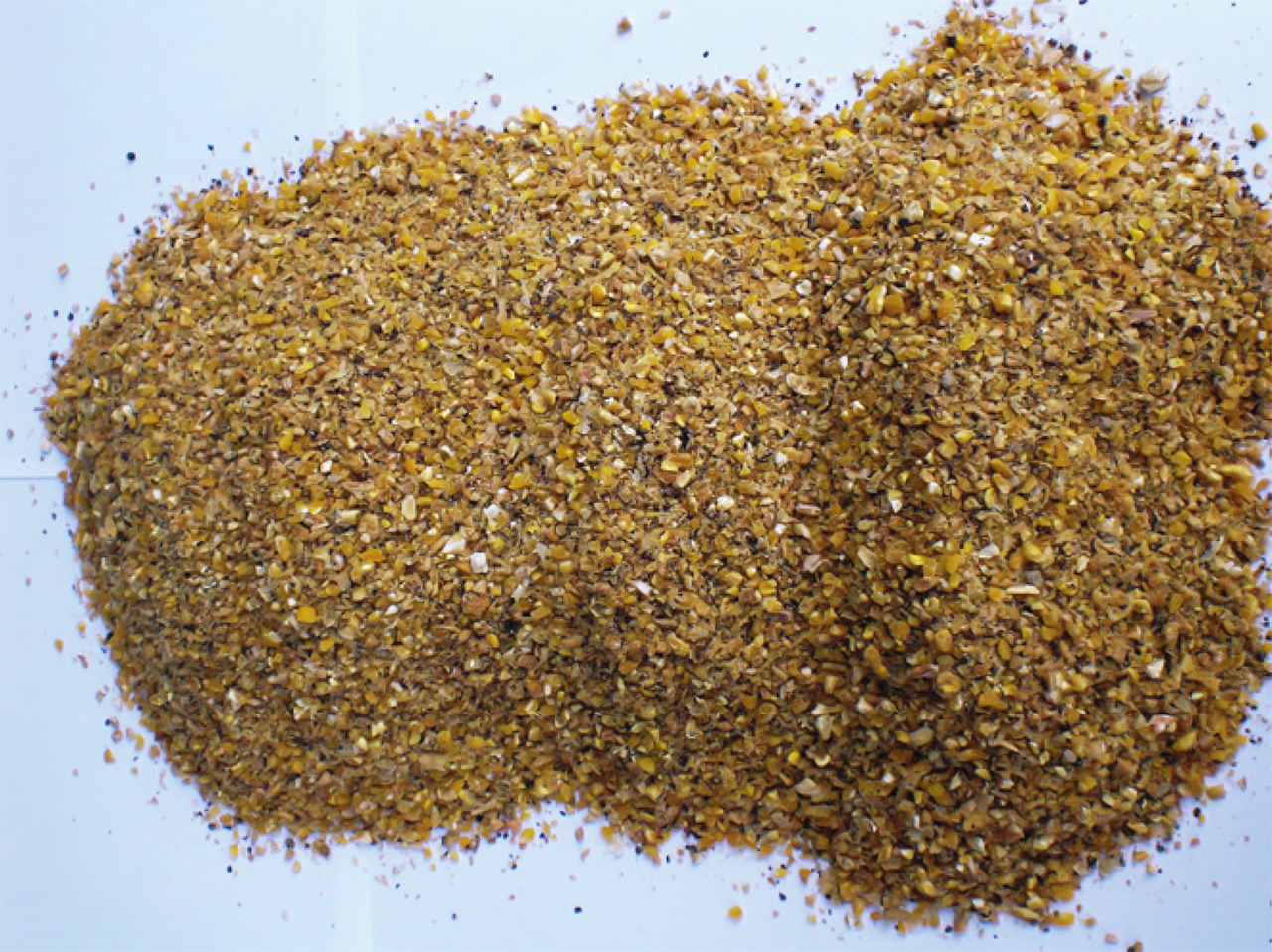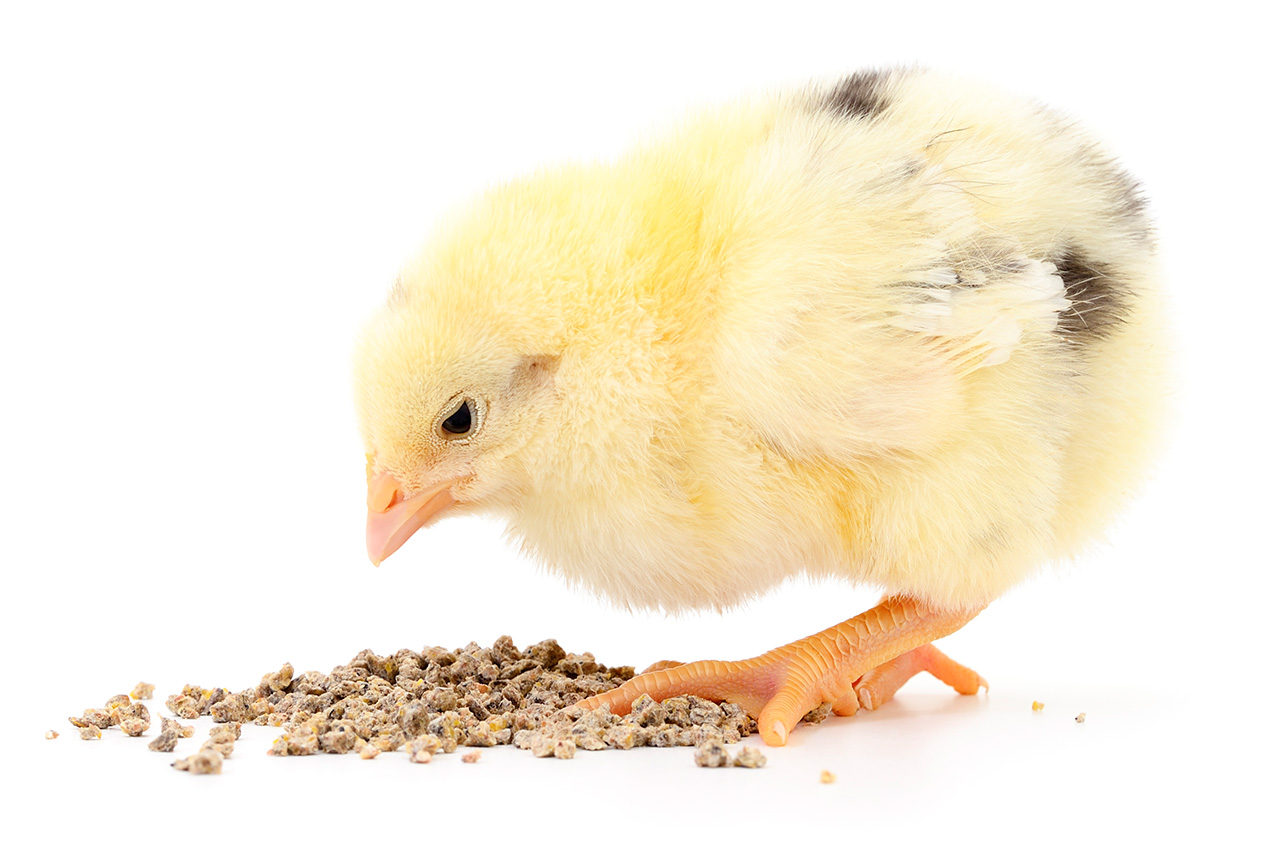Introduction
When you examine the international literature in more detail and listen more closely to colleagues in various countries you very quickly begin to think that this must be a very interesting topic. As research on poultry behaviour has become more common, test results are increasingly proving that crude fibres (roughage) have a positive effect on this complex issue. There are also extensive indications from research and practice that there appears to be a positive correlation with the consistency and moisture content of the faeces and overall intestinal health and therefore the litter quality.
Definition of crude fibre
The expressions, crude fibre and roughage are often equated. This is because crude fibre is an expression, which has been used for a very long time. The term crude fibre comes from animal feed analyses, more precisely from the Weender analysis established in 1864. The Weender analysis records the different animal feed components or substances in their relation to each other and enables a rough estimate of digestion to be made. The value, ‘crude fibre’ describes various structural materials, which are insoluble in diluted acids and alkaline solutions, including an amorphous group of feed components, which are difficult or impossible to digest, and which therefore have a ‘poor reputation’ in poultry nutrition.

Table 1: Nutrient content of selected raw materials, base 88% dry matter
Source: Jeroch & Dänicke Poultry Yearbook 2008, Some Calculations and Data; Energy in accordance with the WPSA [World Poultry Science Association] formula for estimating the content of metabolisable energy in poultry diets; HP – high protein, LP – low protein
Origins of crude fibre
Therefore, when different crude fibres are used, the actual value fluctuates within a range from approx. 2.5% in a maize-soya based mixture up to 6.0 – 7.0 % in mixtures based on barley, sunflower extract meal and cereal by-products such as bran. The crude fibre content in a poultry feed is related on one hand to the energy content of the different raw materials, yet on the other hand it should attract more interest in the preparation of formulae for poultry.

Requirements for crude fibre content in poultry feed
Whereas earlier feeding recommendations emphasised an upper crude fibre limit value on fodder, for various reasons a lower limit value is also necessary, for as a rule raw materials such as these, which are high in energy and contain relatively little crude fibre, are taken into account nowadays for highly productive poultry (both energy and protein animal feed).
Moreover, the formulae sometimes contain considerable proportions of fodder fat. This can very often result in crude fibre contents, which are 3% in complete fodder. For the following reasons, however, we need to attach considerably more importance to the crude fibre content:
The recommendations for optimising crude fibre intake are dependent on the age of the animals, the type of poultry and the use for which the poultry are kept. The contents recommended in each case should not be significantly exceeded, because the nutrient digestibility is or can be reduced and the energy and nutrient concentration of the feed may become the limiting factor for an adequate supply. Exceptions from this are feeding procedures, in which high crude fibre contents are used specifically to restrict energy (e.g. broiler breeders). In addition, in extensive feeding procedures and during non-laying periods (moult) the feed contains higher crude fibre contents.
Where protein providers are concerned, soya products used to be predominantly preferred, whereas in the meantime products made from sunflower seed, rapeseed products and resource protein providers, such as various by-products from bio energy generation have come into use. These raw materials used as alternatives to maize and soya all show higher crude fibre contents and are currently widely used. Furthermore, crude fibre concentrates based on lignocellulose, with a minimum content of 60% of indigestible crude fibre must be mentioned. Their use has proved its worth on many counts and in particular offers the advantage of having the low usage rate of approx. 1% in the formulae, which scarcely displaces all the other raw materials in this respect.

Crude fibre in laying hen feed – how can this be achieved?
Laying hens in the rearing and production phases benefit to a large extent from crude fibre in the feed. This message and this knowledge has for a long time been regularly demonstrated in practice and for some time now has also been analysed from the scientific viewpoint. In this science differentiates between different proportions or fractions of crude fibre. The portion, which should be more closely examined here, is the indigestible portion, such as lignin and cellulose.
Secondly, this is strongly dependent on the availability of suitable raw materials, such as: the cereals barley and oats, any form of cereal by-products whatsoever, sunflower and rapeseed products, DDGS, alfalfa and finally ligno-cellulose concentrations.
The overall level of crude fibre in laying hen feed in rearing and production is determined or calculated by the well-known linear feed optimisation method. This has proved possible up to 7 % and neither the performance not the health of the animals has been adversely affected; sometimes crude fibre in the feed even improves the animals’ health and behaviour. Based on this experience we can state the following: (indigestible) crude fibre will never harm your animals! Moreover, this knowledge is increasingly being taken into account in feeding poultry in general and even in the feeding of animals raised for meat production.
Summary
In conclusion, the question is posed whether the committed animal nutritionist has ‘problems’ with respect to poultry and in particular laying hen feed with the digestibility of crude fibres, or rather has a use for them. It would seem to be time for a paradigm shift.
Literature
Jeroch, Simon, Zentek – Geflügelernährung [Poultry Nutrition] – Ulmer-Verlag 2012 Pottgüter – Fibre in Layer Diets – Lohmann Information, Vol. 43, October 2008
Robert Pottgüter
Crude fibre in poultry feed – what sort of topic is that? When as an animal nutritionist you speak on this topic with poultry farmers, you are (still) often met with incomprehension and embarrassed smiles. Every poultry rearer and farmer knows that crude fibre is important in feeding cow, sows, horses and rabbits – but in poultry feeding? Sometimes colleagues, who work with poultry feed, also reply with a friendly, somewhat uncomprehending smile, when you talk about crude fibre in poultry nutrition or suggest that it should be specifically included in laying hen feed formulae.
When you examine the international literature in more detail and listen more closely to colleagues in various countries you very quickly begin to think that this must be a very interesting topic. As research on poultry behaviour has become more common, test results are increasingly proving that crude fibres (roughage) have a positive effect on this complex issue. There are also extensive indications from research and practice that there appears to be a positive correlation with the consistency and moisture content of the faeces and overall intestinal health and therefore the litter quality.
Definition of crude fibre
The expressions, crude fibre and roughage are often equated. This is because crude fibre is an expression, which has been used for a very long time. The term crude fibre comes from animal feed analyses, more precisely from the Weender analysis established in 1864. The Weender analysis records the different animal feed components or substances in their relation to each other and enables a rough estimate of digestion to be made. The value, ‘crude fibre’ describes various structural materials, which are insoluble in diluted acids and alkaline solutions, including an amorphous group of feed components, which are difficult or impossible to digest, and which therefore have a ‘poor reputation’ in poultry nutrition.

Table 1: Nutrient content of selected raw materials, base 88% dry matter
Source: Jeroch & Dänicke Poultry Yearbook 2008, Some Calculations and Data; Energy in accordance with the WPSA [World Poultry Science Association] formula for estimating the content of metabolisable energy in poultry diets; HP – high protein, LP – low protein
Origins of crude fibre
Crude fibre is used more or less inevitably in all feed formulae. Since ‘officially’ crude fibre makes no contribution to the nutritional value of a poultry feed, but nonetheless must be declared as a maximum value in many countries, the crude fibre content is included for information purposes in all feed calculations and improvements. Usually, no minimum crude fibre requirement is set in poultry feed formulae; a maximum value serves solely to ensure that the specified declaration value is not exceeded.
Therefore, when different crude fibres are used, the actual value fluctuates within a range from approx. 2.5% in a maize-soya based mixture up to 6.0 – 7.0 % in mixtures based on barley, sunflower extract meal and cereal by-products such as bran. The crude fibre content in a poultry feed is related on one hand to the energy content of the different raw materials, yet on the other hand it should attract more interest in the preparation of formulae for poultry.

Requirements for crude fibre content in poultry feed
Whereas earlier feeding recommendations emphasised an upper crude fibre limit value on fodder, for various reasons a lower limit value is also necessary, for as a rule raw materials such as these, which are high in energy and contain relatively little crude fibre, are taken into account nowadays for highly productive poultry (both energy and protein animal feed).
Moreover, the formulae sometimes contain considerable proportions of fodder fat. This can very often result in crude fibre contents, which are 3% in complete fodder. For the following reasons, however, we need to attach considerably more importance to the crude fibre content:
- requirement for the development of the digestive tract in rearing animals (e.g. pullets) in order to facilitate adequate feed intake from the start of laying activity to the peak of laying
- stimulation of gizzard development
- stabilisation of the intestinal flora and therefore improvement in faecal consistency (better litter quality in barn rearing, fewer dirty eggs in all types of housing systems
- prevention of digestive disorders
- therefore reduces the tendency towards (toe and => delete) feather pecking, eating feathers and cannibalism (especially with laying hens).
The recommendations for optimising crude fibre intake are dependent on the age of the animals, the type of poultry and the use for which the poultry are kept. The contents recommended in each case should not be significantly exceeded, because the nutrient digestibility is or can be reduced and the energy and nutrient concentration of the feed may become the limiting factor for an adequate supply. Exceptions from this are feeding procedures, in which high crude fibre contents are used specifically to restrict energy (e.g. broiler breeders). In addition, in extensive feeding procedures and during non-laying periods (moult) the feed contains higher crude fibre contents.
Because the positive use of crude fibres in general has meanwhile been recognised for many breeds of poultry, the range of the raw materials used in the feed has also been extended. Whereas maize used to be the preferred cereal, nowadays wheat is used in particular, as well as triticale, barley, oats to a limited extent and sometimes even rye.
Where protein providers are concerned, soya products used to be predominantly preferred, whereas in the meantime products made from sunflower seed, rapeseed products and resource protein providers, such as various by-products from bio energy generation have come into use. These raw materials used as alternatives to maize and soya all show higher crude fibre contents and are currently widely used. Furthermore, crude fibre concentrates based on lignocellulose, with a minimum content of 60% of indigestible crude fibre must be mentioned. Their use has proved its worth on many counts and in particular offers the advantage of having the low usage rate of approx. 1% in the formulae, which scarcely displaces all the other raw materials in this respect.
In principle the introduction of minimum contents in crude fibres in poultry feed formulae should, however, not result in a “nutrient dilution”, the consequence of which can be reductions in performance on the one hand or increased feed consumption. The possible content in crude fibres in a formula is on the one hand strongly dependent on the availability of the raw materials and on the other on the energy and nutrient concentrations in the formulae concerned.

Crude fibre in laying hen feed – how can this be achieved?
Laying hens in the rearing and production phases benefit to a large extent from crude fibre in the feed. This message and this knowledge has for a long time been regularly demonstrated in practice and for some time now has also been analysed from the scientific viewpoint. In this science differentiates between different proportions or fractions of crude fibre. The portion, which should be more closely examined here, is the indigestible portion, such as lignin and cellulose.
If someone with experience brings a certain amount of knowledge of the topic, crude fibre for laying hens and poultry in general, the next question is how to integrate crude fibre into the laying feed. First and foremost, it must be stated that the incorporation of crude fibres in laying hen feed should not reduce the normal nutrient concentration, because this would have a negative effect on the performance data for the animals.
Secondly, this is strongly dependent on the availability of suitable raw materials, such as: the cereals barley and oats, any form of cereal by-products whatsoever, sunflower and rapeseed products, DDGS, alfalfa and finally ligno-cellulose concentrations.
All these raw materials have a lower nutrient concentration in comparison with maize and soya than the macro commodities most used world-wide for poultry feed. In order not to reduce the overall nutrient concentration in the feed and as a consequence of the intake of the raw materials in the feed mixture discussed above the fat content usually rises. For that reason it must basically be possible to dose or include fat and/or oil in the feed formulation. A significantly higher degree of crude fat in the feed offers a large number of benefits for the feed in rearing and production, e.g. with respect to the technical quality of the (meal) feed and also optimum nutrition for the animals.
The overall level of crude fibre in laying hen feed in rearing and production is determined or calculated by the well-known linear feed optimisation method. This has proved possible up to 7 % and neither the performance not the health of the animals has been adversely affected; sometimes crude fibre in the feed even improves the animals’ health and behaviour. Based on this experience we can state the following: (indigestible) crude fibre will never harm your animals! Moreover, this knowledge is increasingly being taken into account in feeding poultry in general and even in the feeding of animals raised for meat production.
Summary
In conclusion, the question is posed whether the committed animal nutritionist has ‘problems’ with respect to poultry and in particular laying hen feed with the digestibility of crude fibres, or rather has a use for them. It would seem to be time for a paradigm shift.
Literature
Jeroch, Simon, Zentek – Geflügelernährung [Poultry Nutrition] – Ulmer-Verlag 2012 Pottgüter – Fibre in Layer Diets – Lohmann Information, Vol. 43, October 2008
Robert Pottgüter







